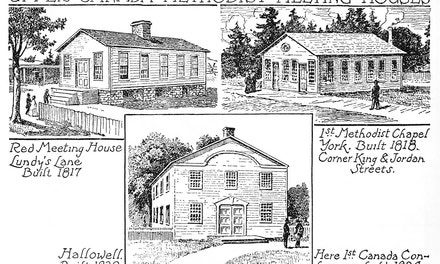On The Niagara Portage Road
Library and Archives Canada, Acc. No. 1972-26-130
Remarks
C.W. Jefferys' notes about this picture from The Picture Gallery of Canadian History Volume 2
The portage past Niagara Falls, until after the Revolutionary War, was on the east side of the river. By about 1789 a new road was opened and in use from Queenston to Chippewa, which became the route for all Canadian traffic. Maude in 1800 speaks of the large numbers of carts drawn by two yokes of oxen or two horses engaged in taking up bales and boxes and bringing down packs of furs. It was an important highway for troops, artillery and supplies during the War of 1812 and the Rebellion of 1837. The hard times of 1837, the competition of the Weiland Canal and later of the railway brought the decline of the road. Full information concerning its history is given in an article by Ernest Green in Vol. 23, Ontario Historical Society, Papers and Records.
Stamford is said to have the only village green in Canada; here were held holiday sports, country fairs and militia musters. The Church of St. John the Evangelist, facing the green, was opened in 1825. It was erected largely by subscriptions from half-pay officers and English gentlemen living in the neighbourhood. Among them was the Lieutenant-Governor, Sir Peregrine Maitland, who purchased in 1822 the beautiful estate of Stamford Park, situated on the brow of the Queenston-St. David's escarpment. The house contained twenty-two rooms, luxuriously furnished. Mrs. Jameson visited it in 1837, and described it as "an elegant English villa with ornamented grounds, combined with some of the wildest and grandest features of the forest scene." The house was later burned and all trace of it has disappeared in the changes which the country has undergone, though the gates of the estate have been salvaged and are now in St. Catharines.
Mrs. Tice was the widow of Major Gilbert Tice, a Loyalist leader of Indians, and associate of Joseph Brant. She lived in the house, probably one of the best in the vicinity, for many years after his death. There are several references to it in the Diary of Mrs. Simcoe, who spent a fortnight there in August, 1793, occupying two rooms, with a tent for her servants. She says there was plenty of shade and cool air, when there was intense heat at Navy Hall at the mouth of the river. There is frequent mention of Mrs. Tice's house during the War of 1812. The dates of the deaths and the place of burial of both her husband and herself are unknown, and nothing remains of the house.
Published References
- Jefferys, Charles W. 1945 The Picture Gallery of Canadian History Volume 2, p.210




Comments